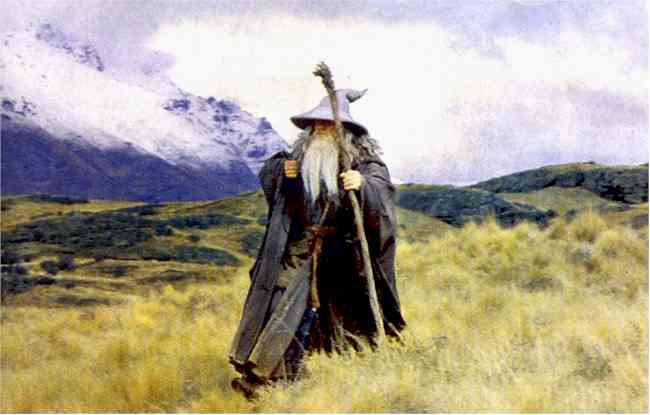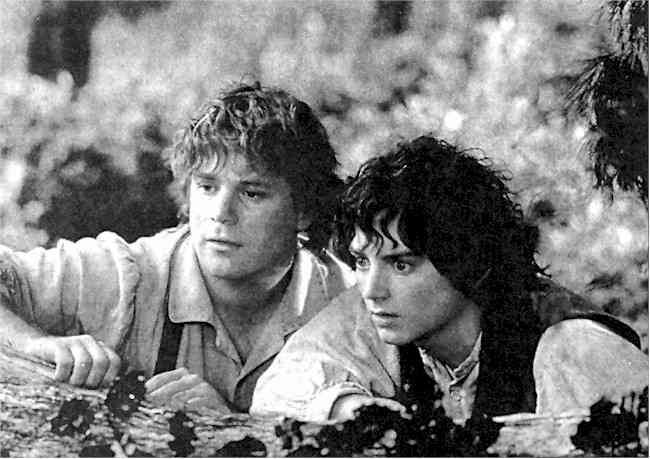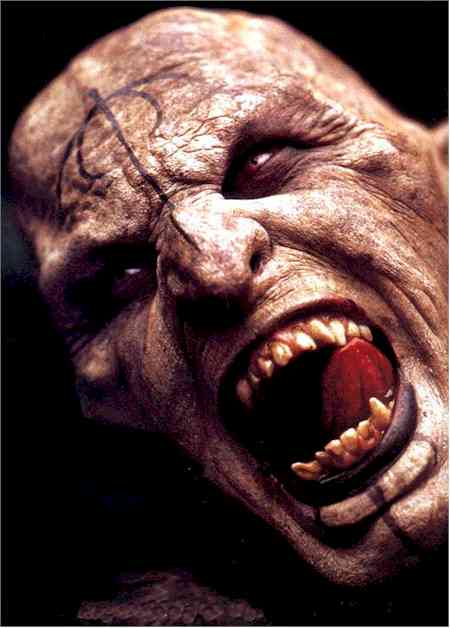Act Like You Like It
Actor Falls for WellingtonWhen the curtain falls, the best thing an actor can do is to go away. - Harold MacMillan
Ian McKellen as Gandalf on the North Island of New Zealand, around Tongariro National Park After a year living in Wellington while filming The Lord of the Rings, actor Sir Ian McKellen can't get New Zealand out of his mind. He has given New Zealand top billing in his British homeland. Sir Ian lived in Eastbourne - the Wellington harbourside suburb he describes in the Independent on Sunday newspaper as a "hamlet" across the "estuary" from Wellington city - for a year, acting in New Zealand director Peter Jackson's fantasy trilogy. Initially apprehensive about whether he would like it, Sir Ian said the charms of New Zealand caused him to dread his return to high-stress London. "A year in New Zealand? I'm indifferent to rugby and don't eat lamb but at least it seemed a good opportunity to visit Australia," he wrote. "Almost at once, however, New Zealand's allure won over and I managed only one weekend in Sydney for a wet and cold Mardi Gras. I was only 10 minutes' drive from the capital city of Wellington, and even less from the fIlm studios of Three Foot Six Ltd, which the director Peter Jackson named after the height of Tolkien's Hobbits. This was the fIrst welcome change from fIlming in London, where Shepperton and Pinewood studios are an hour or more from home. The second was to be working in a beautiful and under-populated country, where the unique ecology overwhelms the urban areas." A keen walker, Sir Ian praised the hills behind Eastbourne as empty of human activity, or the sights and sounds of history and industry. In England, the chimneys of Sellafield nuclear power station still gleamed in the distance at the isolated lake of Wastwater, he lamented. And bomber pilots skimmed the hilltops on deafening practice flights.
Fiction and Fact - Sir Ian McKellen in his The Lord of the Rings role as Gandalf and, right, in real life. Sir Ian, now back in Britain, yearns for New Zealand after a year of living in Wellington. Sir Ian said he was unprepared for New Zealand's wilderness and alpine ranges. "On the West Coast, where the logging of native trees has been recently halted by the Labour Government, the roads that lead alongside the primeval forests to the glaciers are invariably empty. Outside the tourist centres there are no big hotels and there is little choice (even for fIlm crews) but to sample the homestays, with a bed in the spare room and breakfast with the family. The friendly New Zealanders welcome tourists if they 'leave only footprints and take nothing but photos'. Their surroundings are unique and valued and cared for." New Zealanders he worked with were as gently retiring as the national bird, he said. "The rumbustious All Blacks are not typical. High-flying is almost discouraged and ambitious tall poppies are not much admired. "Time and again I met locals who had forsaken well-paid positions in Auckland for rural, more menial jobs, where life could be less stressful. Nationhood and community were more tangible than in Britain, he said." New Zealand television programmes "thin as they are, have a charming bias towards the UK: 'TVNZ celebrates its 25th year of broadcasting with the latest episode of Coronation Street'. "I missed the variety and traditional high standards of our own terrestrial television, only to find, on my return, that it was swamped with a cheap output of general knowledge quizzes chat shows, endurance tests and make-overs of faces, houses and gardens." - NZPA Source: The Evening Post Tuesday 20 March 2001
Wellingtonby Jayne Clark and Stephen Schaefer New Zealand's capital was headquarters for the LOTR production, and city officials don't want the world to forget it. The delightful and compact waterfront city is surrounded by low-Iying hills, houses precariously balanced on their slopes. Its downtown is divided into four thoughtfully color-coded districts that run from button-down to funky. Homegrown designers showcase their wares in sleek shops. Te Papa, the colossal national museum, blends art, history, technology and a healthy dose of fun with lots of interactive, amusement-park-inspired attractions. And a thriving restaurant scene is all the more tempting for its relative affordability. For example, at Logan Brown (a favourite of some of the LOTR's cast), a fabulous restaurant in a palatial 1920s bank building, dinner for two is under $60. Mount Victoria is one of the green oases in the seaside capital that appear in the film. Other locales: Fort Dorset in residential Seatoun (Bree) and Kaitoke Regional Park (Rivendell and the River Anduin). The capital sports a quirky mix of one-of-a-kind shops, sidewalk cafes and good restaurants. Source: USA Today Friday 14 December 2001
Movie Takes Different Tack from Tolkien
One particularly poignant aspect of J R R Tolkien's novel Lord of the Rings is the friendship of Sam, by Bonnie Waring It was as if Gandalf the Grey had cast a spell over the audience. From bloody battles to the sweet music of the elves, from the eerie Mines of Moria to the strange and lovely city of Rivendell, The Lord of the Rings: The Fellowship of the Ring bombarded movie patrons with fantastic images of the legendary Middle-earth. This incredible movie, however, was quite different from the book upon which it was based. That author J R R Tolkien's gentle prose and quiet humour could have been the inspiration for such an action-packed film seems almost ludicrous. But though the styles were quite different, both mediums sustained the essential themes of the story. Tolkien's book needs to be read more than once in order to appreciate his gift for storytelling. The book is almost bland at first; however, the reader comes to realise that this subtlety is what makes the book so special. A novel full of gory battle scenes is interesting only once, but the story of the Ring has so many different shades of meaning that it doesn't need drama. Tolkien is able to use a slight intonation of the voice, the whinny of a black horse, or the repetition of a word to convey a feeling of terror. In addition, his portrayals of the relationships between humans (or hobbits) are remarkably well done for a writer of fantasy: particularly poignant is the friendship of Frodo and Sam, which is drawn deftly but delicately. Despite this subtle style, though, his three most important themes are clear:
The movie, however, left nothing to the imagination. It is true that some episodes narrated in the novel - the encounter with Tom Bombadil, for instance - were left out. And although the scriptwriters and actors did a wonderful job, there was simply not enough time to develop the characters as fully as in the book. But whatever scenes were included were vivid and lush. Everything, from the gigantic fiery Balrog right down to the leaf-shaped clasp on Frodo's cape, was rendered in stunning detail. Particularly impressive were the scenes centering on the evil powers of the Ring; the special effects were more elaborate and believable than any I have ever seen before. There was also much beauty in this fIlm: Rivendell, the city of the Elves, was absolutely stunning. Nestled in a lush green forest, the delicate spires and pearly fairy bridges seemed to glow with a light all their own. Some of the costumes, particularly the Elf queen Galadriel's pearl-encrusted gown, also were breathtaking. Themes of the novelThe movie stayed true to the core themes of the novel; the evil force of the Ring was portrayed quite well. In addition, the fIlm resisted the temptation to ruin the integrity of Frodo, the main character, by making him some sort of muscle-bound superhero. Frodo remained vulnerable: a short, pudgy little hobbit more fond of a good meal and a pipe than great adventures. Whenever a book is developed into a movie, readers and viewers always ask, "Which is better?" Usually one is clearly superior to the other. But in this case, the novel and the fIlm complement one another. The action-packed fIlm serves as an illustration for the quieter but much more intellectual novel. It imaginatively portrays the settings of the book, enabling the reader to focus more on its complex themes. Thus, both accomplish what they set out to do. In both media, The Lord of the Rings is truly a great accomplishment. Bonnie Waring is a sophomore at Villa Walsh Academy. Source: Daily Record Morris County [NJ] edition Friday 18 January 2002; photo credit New Line Cinema
His Parents Couldn't Afford Braces
A Peter Jackson Orc Source: www1.tolkienonline.com
The Great Feet of Lord of the RingsThe new Lord of the Rings films are about magic and mysticism - and the project's facts and figures are pretty spellbinding too. The trilogy was the first to be made simultaneously and kept its army of actors and crew employed for 18 months. It used one million yards of film, 20,600 extras, 350 sets, 1,000 suits of armour and 2,000 pairs of latex hobbit feet. At the height of production in New Zealand, Lord of the Rings had a crew of 2,400. Every object in Middle Earth was made from scratch, including more than 20,000 household and everyday objects, 2,000 rubber weapons, 100 special hand-made weapons, 1,000 suits of hand-made armour and of course, the hobbit feet and ears. Creating the feet was a feat in itself. Richard Taylor, of film effects firm Weta, said: "We made 1,800 pairs of the feet for the lead hobbits alone. "We had feet coming out of our ears." Each foot was used just once since it had to be glued on and ripped off at the end of the day. The 1,000 suits of armour contained 48,000 pieces, each hand-made from plate steel. Weta also had to bring Middle Earth's bizarre creatures to life. Each of the 200 ferocious orcs had an individually-shaped mask implanted with yak hair. The film makers faced a problem with scale - hobbits are supposed to be just 3'6" but were played by adult actors. So larger versions of most sets were constructed to make the hobbits appear small. Bigger weapons and pieces of armour had to be made too. Peter Owen, of Bristol make-up company Owen King, had up to 50 people doing hair and make-up and each cast member spent an average of two hours a day being transformed. Some of the film sets were the most complex ever made. Construction of Hobbiton, where Frodo lives, began a year before filming started. On an eight-acre grassy farm, vegetables, flowers and 550 yards of hedges were planted and maintained by four full-time gardeners for 12 months. A 100ft oak tree was built, with 250,000 hand-painted leaves and artificial acorns. Source: susannassoapbox.com See also:
For satellite photos and pictures of Wellington from several different angles and for articles about earthquakes, history, business, the Ohariu Valley, statistics, fireworks, the
national anthem, the kiwi icon and more click the "Up" button below to take you to the Index for this Wellington section. |
 Animals
Animals Animation
Animation Art of Playing Cards
Art of Playing Cards Drugs
Drugs Education
Education Environment
Environment Flying
Flying History
History Humour
Humour Immigration
Immigration Info/Tech
Info/Tech Intellectual/Entertaining
Intellectual/Entertaining Lifestyles
Lifestyles Men
Men Money/Politics/Law
Money/Politics/Law New Jersey
New Jersey Odds and Oddities
Odds and Oddities Older & Under
Older & Under Photography
Photography Prisons
Prisons Relationships
Relationships Science
Science Social/Cultural
Social/Cultural Terrorism
Terrorism Wellington
Wellington Working
Working Zero Return Investment
Zero Return Investment


